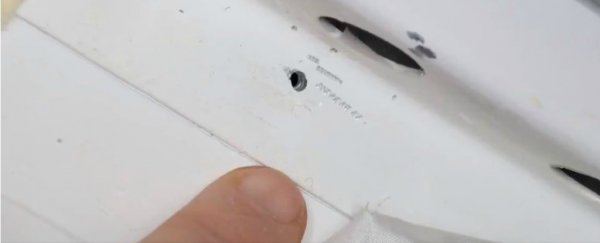Last week astronauts on board the International Space Station (ISS) awoke to a worrying message from flight control.
Hidden somewhere on board the ISS was a tiny pressure leak that was slowly allowing air to seep out of the spacecraft and into the abyss.
The six astronauts on board were not in any imminent danger, although locating the leak was their top priority for the day. The US crew hunkered down in the Russian segment and sealed off all the compartments one by one.
A two millimetre hole was at last discovered in the Russian segment itself. And while that hole may not seem very big, if nothing had been done to fix it, it would have deprived the ISS of air in just 18 days.
The hole was immediately sealed over with a special type of tape to buy the astronauts some time for a permanent solution.
Meanwhile, a special commission was set up by the Russian State Space Corporation Roscosmos to investigate the cause of the rupture. What they found was unexpected.
At first it seemed likely that the tiny hole had come from a micrometeoroid impact - one of the many bullets of debris that whizz around in space.
The theory was even supported by former astronaut Scott Kelly, who explained that this sort of thing happens all the time.
"We've dodged a lot of bullets over the past 20 years," he tweeted.
This leak seems to have resulted from a micrometeoroid impact. We’ve dodged a lot of bullets over the past 20 years. There’s a lot of space junk up there, a serious issue which needs to be addressed. Great job by the #ISS crew! https://t.co/5IfjnimyPz
— Scott Kelly (@StationCDRKelly) August 31, 2018
But as the inquiry progressed, the hole began to look more and more like it came not from the outside, but from the inside.
"We are considering all the theories," said Dmitry Rogozin, head of Roscosmos, according to the Russian news agency Tass.
"The one about a meteorite impact has been rejected because the spaceship's hull was evidently impacted from inside".
Then, things began to get shadier. A photo, released by NASA and then mysteriously deleted, reveals what looks strangely like a drill hole.
"It was done by a human hand - there are traces of a drill sliding along the surface," confirmed Rogozin.
ISS Leak summary:
— NSF - NASASpaceflight.com (@NASASpaceflight) September 3, 2018
First thought was MMOD strike.
Then NASA released pics. Lots of people: "Hmmm, doesn't look like MMOD". NASA deleted the photos.
Top Russian news site RIA NOVOSTI reported - via sources but apparently confirmed by Mr. Rogozin - it was a drill hole. pic.twitter.com/520kHK0TMc
Rogozin assured the media and the public that the Russian space agency was doing everything it could to find the culprit.
"It is a matter of honour for Energia Rocket and Space Corporation to find the one responsible for that, to find out whether it was an accidental defect or a deliberate spoilage and where it was done - either on Earth or in space," he said, referring to the Russian manufacturer of the space craft.
Right now, the leading theory comes from an unnamed source at Energia, which told the Russian news agency RIA Novosti that "[t]he hole was made on the ground" and that "[t]he person responsible for the act of negligence has been identified".
Another anonymous source confirmed that the hole was accidentally drilled by a worker at Energia, who decided to hide their mistake with a seal and decorative fabric instead of reporting it.
For two months, the gamble paid off. Their patchy solution even managed to pass the spacecraft's pressurisation tests before it was launched into space to meet up with the ISS. But then, the seal began to leak.
"[Once in orbit], the glue dried and was squeezed out, opening the hole," the second source told RIA Novosti.
Repairing the hole has been neither simple nor straightforward, and the problem may have even caused a few cracks between Moscow and Houston.
It appears that the Russian space agency wanted to immediately and permanently seal the breach with a special glue, adding insulation and medical gauze on top.
But NASA astronaut Andrew Feustel, who is currently in charge of the 56th ISS mission, was uncomfortable with the plan. In audio from the event, Feustel asks flight control in Houston if the proposed glue has any expanding properties to it.
"Andrew, right now, we are not completely sure all the properties that that sealant that Moscow is talking about. We're discussing with them right now," flight control replies.
Not satisfied with the answer, Feustel can be heard requesting 24 hours of extra time so that the procedure can be tested on Earth.
"I would really like to see a test of that, somehow, on the ground before we do a test up here and see if it's going to work," Feustel says.
"We sort of feel like we've got one shot at it and if we screw it up, then the implications are one of these vehicles is going home, or that vehicle is going home, sooner than later".
But without another option on the table, Moscow insisted on their plan. After just an hour or so, the decision was made to go ahead with their proposed solution. A second patch was added the next day, and pressure in the ISS now appears to be stable.
Rogozin told reporters that they were looking into whether the hole was made because of negligence, or if it was made deliberately.
"Now it is essential to see the reason, to learn the name of the one responsible for that," he said.
"And we will find out, without fail".
There has been no further statement from Roscosmos about the latest allegations that a worker at Energia is responsible.
